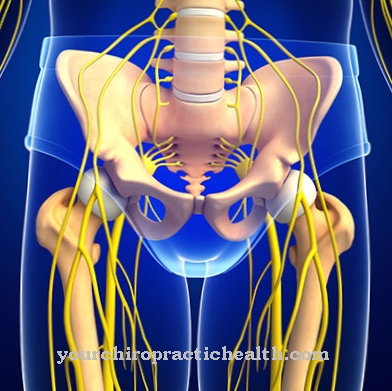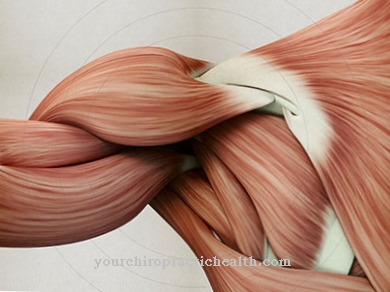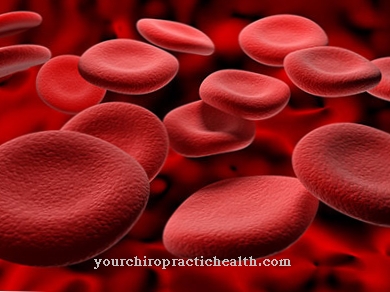The Okihiro syndrome is a complex of malformations that mainly affect the upper extremities. These malformations are associated with a so-called Duane anomaly, which the patient cannot see outward. Treatment is purely symptomatic and usually consists of surgical corrections of the individual symptoms.
What is Okihiro Syndrome?

© Siarhei - stock.adobe.com
Malformation syndromes are congenital diseases that manifest themselves as a complex of deformities of various parts of the body. The Okihiro syndrome is one such malformation syndrome. In the English-speaking world, the complex of malformations is called Duane Radial Ray Syndrome designated.
Symptoms of the syndrome primarily affect the upper limbs and are characteristically associated with a Duane anomaly of the eyes. The exact prevalence of the syndrome is unknown. However, it is estimated that it is a rather rare disease with an estimated prevalence of at most one affected person in 100,000 people.
The malformations manifest themselves immediately after birth and have a hereditary basis. The inheritance corresponds to the autosomal dominant inheritance. Inheritance could not be traced in all cases. Despite the general heredity, the symptom complex is presumably based on a genetic new mutation as the cause in many cases.
causes
Okihiro syndrome is caused by genetic mutations in the SALL4 gene on chromosome 20 in the gene locis q13.13 to 13.2. The thalidomide thalidomide embryopathy is due to genetic defects in the same gene. In most cases, the genetic defects in Okihiro syndrome correspond to a new mutation of the gene, but they can also occur in families.
The SALL4 gene codes for a transcription factor of the same name, which contains instructions for the biosynthesis of proteins. Transcription factors bind certain areas of the DNA and keep the function and activity of the corresponding genes under control. Mutations in the SALL4 gene prevent one copy of the genes in each body cell from biosynthesizing the proteins.
How exactly this connection with the individual symptoms of Okihiro syndrome is causally related is so far unclear. The influence of external factors on the causal mutation of the gene has not yet been clarified.
Symptoms, ailments & signs
Patients with Okihiro syndrome suffer from a complex of clinical symptoms, most of which manifest themselves as malformations of the upper limbs. These malformations are often confused with those of Holt-Oram syndrome. The multiple malformations in Okihiro syndrome are associated with a so-called Duane anomaly.
This is a special kind of strabismus symptoms. Patients cannot look outside. Limb malformations in the syndrome primarily affect the thumbs. A possible manifestation is, for example, the threefold structure of the thumb, but underdeveloped thumbs are also conceivable.
In contrast to Holt-Oram syndrome, the thumbs in Okihiro syndrome can also be in a surplus shape and thus correspond to a preaxial polydactyly. Usually the thumb malformations of the patients are associated with those of the radius. The upper limbs are shortened in many cases. In some cases, this shortening extends to phocomelia.
In addition to these malformations, kidney malformations or unusual positions of this organ are often present. Hearing impairments and ear malformations occur in around a fifth of patients. Malformations of the feet also occur. Heart defects mostly affect the atrial septum or correspond to a ventricular septum defect. Growth hormonal deficiency, short stature and anal atresia were observed less frequently in the patient.
Diagnosis & course of disease
The doctor first suspects Okihiro syndrome through visual diagnosis due to the characteristic malformations of the upper limbs. Imaging of the kidneys and heart can further strengthen the suspicion. Syndromes such as thalidomide (thalidomide) embryopathy, Holt-Oram syndrome and Townes-Brocks syndrome can be excluded from the differential diagnosis.
In addition, the Okihiro syndrome must be differentiated from the thrombocytopenia-absent-radius syndrome in a differential diagnosis. In some of the syndromes mentioned, this differentiation is only possible through a single symptom. The life expectancy of patients with Okihiro syndrome is no longer reduced. The severity of the organic malformations determines the prognosis in each individual case.
Complications
Due to Okihiro syndrome, patients suffer from various malformations and malformations. These limit the everyday life and quality of life of those affected considerably, so that mental disorders or depression can also occur. It can lead to teasing or bullying, especially among children and young people. The malformations of Okihiro syndrome primarily affect the limbs and can lead to severe restrictions on movement.
The fingers are also affected, so that the children are restricted in their development.Furthermore, patients suffer from malformations of the ears due to the syndrome and thus also from various hearing problems. Short stature or generally delayed development can also occur in this syndrome.
The children are therefore often dependent on the help of other people in their lives. Even in adulthood, it can lead to various complications or complaints. A causal treatment of Okihiro syndrome is not possible. However, most malformations can be corrected surgically. There are usually no complications. Furthermore, the life expectancy of the patient is usually not reduced by the syndrome.
When should you go to the doctor?
Okihiro syndrome is usually diagnosed immediately after the child is born and always requires medical treatment. The various malformations and visual problems must be examined and treated by the respective specialist. For this purpose, parents should speak to their family doctor or pediatrician, who can recommend suitable doctors. During the treatment of Okihiro syndrome, close consultation with doctors is also necessary so that any complaints and side effects can be responded to quickly. If the child has severe limb malformations, an orthopedic surgeon must also be consulted. Regular physiotherapy is then indicated.
Depending on the severity of the disease, further physiotherapeutic measures are necessary, for example to improve posture or motor skills. Children who suffer from the symptoms require the help of a doctor for their entire life. For example, kidney function must be monitored continuously.
In the course of life, there can also be further complaints of the ears and eyes, which must be diagnosed and treated at an early stage. Anyone who is affected themselves or has cases of the disease in their families should have a screening carried out early on if they are pregnant. In this way it can be determined whether the offspring also suffers from Okihiro syndrome.
Treatment & Therapy
A causal therapy is currently not available for people with Okihiro syndrome. For this reason, the syndrome has so far been considered an incurable disease. Gene therapy approaches would be the only conceivable option for causal treatment, as they could eliminate the genetic cause. However, these approaches are not yet in the clinical phase. Therefore, Okihiro syndrome must be treated purely symptomatically.
The therapy depends on the symptoms and their severity in the individual case. In terms of therapy, the primary focus is initially on correcting the heart defect. This correction is invasive. Since it is mostly a mild heart defect, numerous standard correction procedures are available. The patient's kidney function must be monitored frequently.
If a functional disorder of the kidneys sets in due to the misalignment, this syndrome can also be eliminated by means of a surgical intervention by repositioning the kidneys. Shape-related impairments of the kidneys can only be remedied by a transplant. In addition to the organic malformations, malformations of the extremities are also treated surgically.
In addition, a squint operation is usually performed to resolve the Duane anomaly. If a hearing test reveals impairment of auditory perception, a fitting with implants may improve these symptoms. Extremely mild forms of Okihiro syndrome may not require invasive interventions.
Outlook & forecast
Even if a variety of malformations can occur in the genetically caused Okihiro syndrome, the prognosis for those affected is overall good. Many of the malformations caused by spontaneous mutations can be corrected surgically or therapeutically. The life expectancy of those affected with Okihiro syndrome is on average just as high as that of all other people.
What is necessary, however, is a comprehensive diagnosis. This must take into account the possible congruence of symptoms in similar diseases. A misdiagnosis can worsen the prognosis. If hearing problems arise due to Okihiro syndrome, these should be recognized at an early stage. Heart defects or squinting eyes can usually be corrected surgically. Something similar is also the case if the mutation has resulted in malformations on the fingers or extremities.
Since individual malformations can be present in different degrees of severity, the surgical correction options are influenced by this. Sometimes there are permanent restrictions on movement, short stature or missing fingers. Such damage cannot be repaired despite modern medical options. Those affected often need lifelong support.
Another problem is that bullying at school can occur due to the different appearance of the children concerned. In such cases, mental illness, feelings of inferiority, or depression occasionally occur. The better the results of symptomatic treatment and surgical measures, the more positive the prognosis for those affected.
prevention
External factors influencing the development of Okihiro syndrome are not yet known. Because of this, the syndrome is difficult to prevent. The only preventive measure so far has been genetic counseling.
Aftercare
In most cases, those affected with Okihiro syndrome have very few or no special follow-up measures available. Since this is a genetically determined disease, the person affected should ideally initiate treatment very early to prevent the symptoms from worsening or other complications.
If you want to have children, genetic testing and counseling can be useful to prevent the syndrome from recurring. As a rule, self-healing cannot occur. Most of those affected depend on regular checkups by a doctor. The internal organs in particular should be checked regularly, as the heart and kidneys in particular can be negatively affected by Okihiro syndrome.
Hearing aids can also be used for hearing problems. Children with Okihiro syndrome need to be given special support in their lives in order to cope with their everyday lives as well as possible. Here, loving conversations are often necessary in order to prevent psychological upsets or depression. This disease may reduce the life expectancy of the person affected, although a general prediction of the further course is usually not possible.
You can do that yourself
In Okihiro syndrome, treatment focuses on treating the individual malformations surgically and providing therapeutic support for those affected. The sick person can contribute to a speedy recovery by observing good personal hygiene after the surgical procedures and following the instructions of the doctor regarding physical activity and dietary measures.
In general, a protein-rich diet with sufficient vitamins and minerals is recommended, as these substances promote wound healing and thus ensure rapid healing. Caffeine, alcohol and spicy foods should be avoided for the first few days to weeks after the procedure. People who have already had several malformations surgically treated usually suffer greatly from the visible scars. A conversation with a psychologist helps to process the consequences of the illness and to avoid the development of serious emotional complaints.
In later life it can be useful to seek genetic counseling. Expectant parents in particular should find out about the risks for the child at an early stage and, if necessary, have a genetic test carried out so that the necessary preparations can be made before the child is born.



























